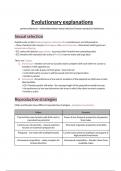Summary
Summary Relationships notes for AQA A level Psychology
- Course
- Institution
Notes for all spec points of AQA A Level Psychology - Relationships topic. It involves key definitions, research, and AO3 evaluation points. Very detailed so you don't need to memorise all information but provides good insight.
[Show more]




